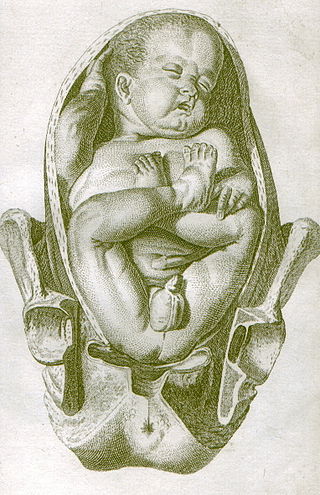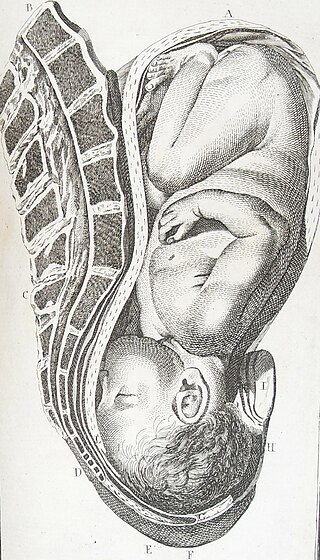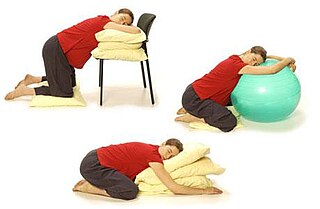Related Research Articles

The occipital bone is a cranial dermal bone and the main bone of the occiput. It is trapezoidal in shape and curved on itself like a shallow dish. The occipital bone overlies the occipital lobes of the cerebrum. At the base of the skull in the occipital bone, there is a large oval opening called the foramen magnum, which allows the passage of the spinal cord.

A breech birth is when a baby is born bottom first instead of head first, as is normal. Around 3–5% of pregnant women at term have a breech baby. Due to their higher than average rate of possible complications for the baby, breech births are generally considered higher risk. Breech births also occur in many other mammals such as dogs and horses, see veterinary obstetrics.

External cephalic version (ECV) is a process by which a breech baby can sometimes be turned from buttocks or foot first to head first. It is a manual procedure that is recommended by national guidelines for breech presentation of a pregnancy with a single baby, in order to enable vaginal delivery. It is usually performed late in pregnancy, that is, after 36 gestational weeks, preferably 37 weeks, and can even be performed in early labour.
The obstetrical dilemma is a hypothesis to explain why humans often require assistance from other humans during childbirth to avoid complications, whereas most non-human primates give birth unassisted with relatively little difficulty. This occurs due to the tight fit of the fetal head to the maternal birth canal, which is additionally convoluted, meaning the head and therefore body of the infant must rotate during childbirth in order to fit, unlike in other, non-upright walking mammals. Consequently, there is a usually high incidence of cephalopelvic disproportion and obstructed labor in humans.

In obstetrics, Leopold maneuvers are a common and systematic way to determine the position of a fetus inside the woman's uterus. They are named after the gynecologist Christian Gerhard Leopold. They are also used to estimate term fetal weight.

Huabeisaurus was a genus of dinosaur from the Late Cretaceous. It was a sauropod which lived in what is present-day northern China. The type species, Huabeisaurus allocotus, was first described by Pang Qiqing and Cheng Zhengwu in 2000. Huabeisaurus is known from numerous remains found in the 1990s, which include teeth, partial limbs and vertebrae. Due to its relative completeness, Huabeisaurus represents a significant taxon for understanding sauropod evolution in Asia. Huabeisaurus comes from Kangdailiang and Houyu, Zhaojiagou Town, Tianzhen County, Shanxi province, China. The holotype was found in the unnamed upper member of the Huiquanpu Formation, which is Late Cretaceous (?Cenomanian–?Campanian) in age based on ostracods, charophytes, and fission-track dating.

Fundal height, or McDonald's rule, is a measure of the size of the uterus used to assess fetal growth and development during pregnancy. It is measured from the top of the mother's uterus to the top of the mother's pubic symphysis. Fundal height, when expressed in centimeters, roughly corresponds to gestational age in weeks between 16 and 36 weeks for a vertex fetus. When a tape measure is unavailable, finger widths are used to estimate centimeter (week) distances from a corresponding anatomical landmark. However, landmark distances from the pubic symphysis are highly variable depending on body type. In clinical practice, recording the actual fundal height measurement from the palpable top of the uterus to the superior edge of the pubic symphysis is standard practice beginning around 20 weeks gestation.

Obstetrical forceps are a medical instrument used in childbirth. Their use can serve as an alternative to the ventouse method.

A vaginal delivery is the birth of offspring in mammals through the vagina. It is the most common method of childbirth worldwide. It is considered the preferred method of delivery, with lower morbidity and mortality than Caesarean sections (C-sections).
Anterior shoulder in obstetrics refers to that shoulder of the fetus that faces the pubic symphysis of the mother during delivery. Depending upon the original position of the fetus, either the left or the right shoulder can be the anterior shoulder. It is known as the anterior shoulder as it faces the anterior of the mother. This distinction between the anterior and the posterior shoulder is important as the anterior shoulder is delivered first.

In obstetrics, the presentation of a fetus about to be born specifies which anatomical part of the fetus is leading, that is, is closest to the pelvic inlet of the birth canal. According to the leading part, this is identified as a cephalic, breech, or shoulder presentation. A malpresentation is any presentation other than a vertex presentation.
Posterior shoulder in obstetrics refers to the shoulder of the fetus other than the anterior shoulder. Thus, the posterior shoulder faces the rectum of the mother during delivery. Whether left or the right shoulder becomes the posterior shoulder is dependent upon the original position of the fetus. It is known as the posterior shoulder as it faces the posterior of the mother. This distinction between the anterior and the posterior shoulder is important as the anterior shoulder is delivered first.

A shoulder presentation is a malpresentation at childbirth where the baby is in a transverse lie, thus the leading part is an arm, a shoulder, or the trunk. While a baby can be delivered vaginally when either the head or the feet/buttocks are the leading part, it usually cannot be expected to be delivered successfully with a shoulder presentation unless a cesarean section (C/S) is performed.

A cephalic presentation or head presentation or head-first presentation is a situation at childbirth where the fetus is in a longitudinal lie and the head enters the pelvis first; the most common form of cephalic presentation is the vertex presentation, where the occiput is the leading part. All other presentations are abnormal (malpresentations) and are either more difficult to deliver or not deliverable by natural means.

The pelvis is the lower part of the trunk, between the abdomen and the thighs, together with its embedded skeleton.
The fetal head, from an obstetrical viewpoint, and in particular its size, is important because an essential feature of labor is the adaptation between the fetal head and the maternal bony pelvis. Only a comparatively small part of the head at term is represented by the face. The rest of the head is composed of the firm skull, which is made up of two frontal, two parietal, and two temporal bones, along with the upper portion of the occipital bone and the wings of the sphenoid.
Locked twins is a rare complication of multiple pregnancy where two fetuses become interlocked during presentation before birth. It occurs in roughly 1 in 1,000 twin deliveries and 1 in 90,000 deliveries overall. Most often, locked twins are delivered via Caesarean section, given that the condition has been diagnosed early enough. The fetal mortality rate is high for the twin that presents first, with over 50% being stillborn.

Back labor is a term referring to sensations of pain or discomfort that occur in the lower back, just above the tailbone, to a mother during childbirth.

Emergency childbirth is the precipitous birth of an infant in an unexpected setting. In planned childbirth, mothers choose the location and obstetric team ahead of time. Options range from delivering at home, at a hospital, a medical facility or a birthing center. Sometimes, birth can occur on the way to these facilities, without a healthcare team. The rates of unplanned childbirth are low. If the birth is imminent, emergency measures may be needed. Emergency services can be contacted for help in some countries.
Yuanjiawaornis is an extinct genus of large enantiornithean bird known from the early Cretaceous of present-day China. It is monotypic, with only type species Y. virisosus known.
References
- ↑ Kish, Karen; Joseph V. Collea (2003). "Malpresentation & Cord Prolapse (Chapter 21)". In Alan H. DeCherney (ed.). Current Obstetric & Gynecologic Diagnosis & Treatment. Lauren Nathan (Ninth ed.). Lange/McGraw-Hill. p. 369. ISBN 0-07-118207-1.